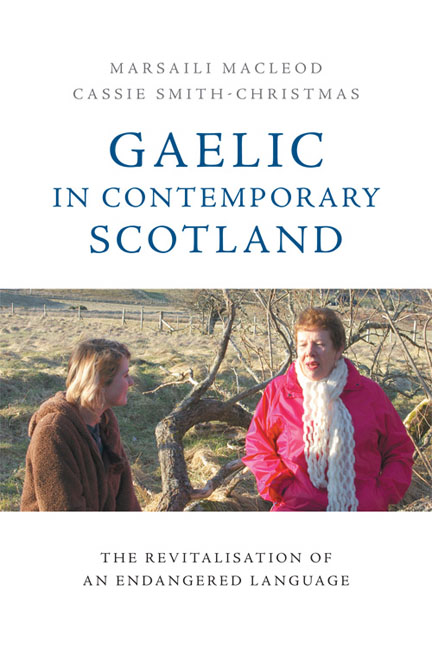Book contents
- Frontmatter
- Contents
- List of Figures
- List of Tables
- Notes on Contributors
- Foreword: Assailed yet Resolute
- Acknowledgements
- List of Abbreviations
- 1 Introduction
- 2 The Language of the Playground: Activists Building Consensus on the Language Policy and Ethos of a New Gaelic Immersion School
- 3 Mismatches between National and Local Gaelic Development: Cròileagan Dùn Èideann and the Promotion of Gaelic-medium Education
- 4 Gaelic amongst Schoolchildren: Ideas on Language Change and Linguistic Choices in Gaelic
- 5 When School is Over and Done With: Linguistic Practices and Sociodemographic Profiles of Gaelic-medium Educated Adults
- 6 New Speakers of Gaelic: A Historical and Policy Perspective
- 7 Learning Gaelic in Adulthood: Second Language Learning in Minority Language Contexts
- 8 Dlùth is Inneach: Charting Language Ideology in the Contemporary Gaelic World
- 9 Gaelic Language Use in Public Domains
- 10 Planning for Growth: The Professionalisation of the Taskforce for Gaelic Revitalisation
- 11 Organisational Language Planning: Gaelic Language Plans in the Public Sector
- 12 The Future of Gaelic Language Revitalisation in Scotland
- Index
1 - Introduction
Published online by Cambridge University Press: 18 December 2019
- Frontmatter
- Contents
- List of Figures
- List of Tables
- Notes on Contributors
- Foreword: Assailed yet Resolute
- Acknowledgements
- List of Abbreviations
- 1 Introduction
- 2 The Language of the Playground: Activists Building Consensus on the Language Policy and Ethos of a New Gaelic Immersion School
- 3 Mismatches between National and Local Gaelic Development: Cròileagan Dùn Èideann and the Promotion of Gaelic-medium Education
- 4 Gaelic amongst Schoolchildren: Ideas on Language Change and Linguistic Choices in Gaelic
- 5 When School is Over and Done With: Linguistic Practices and Sociodemographic Profiles of Gaelic-medium Educated Adults
- 6 New Speakers of Gaelic: A Historical and Policy Perspective
- 7 Learning Gaelic in Adulthood: Second Language Learning in Minority Language Contexts
- 8 Dlùth is Inneach: Charting Language Ideology in the Contemporary Gaelic World
- 9 Gaelic Language Use in Public Domains
- 10 Planning for Growth: The Professionalisation of the Taskforce for Gaelic Revitalisation
- 11 Organisational Language Planning: Gaelic Language Plans in the Public Sector
- 12 The Future of Gaelic Language Revitalisation in Scotland
- Index
Summary
It seems apt to open this volume with a quote from Nancy C. Dorian, whose work on the Gaelic spoken in East Sutherland has not only profoundly shaped scholarship on Scottish Gaelic sociolinguistics as a whole, but has guided research on language shift and maintenance for decades now. In 1987 Dorian wrote:
In the fifteen years during which I was constantly visiting the East Sutherland district of the northeast Scottish mainland or living there, actively studying its distinctive and unique flavor, I was asked many times whether my activities or indeed anyone else's could make any difference to the ultimate fate of the dialect. But I was never asked that question by a native of the region. (Dorian 1987: 233)
More than thirty years later, as the authors in this volume can attest, this question still lies at heart of conducting research on the social and linguistic dynamics of the Gaelic (Gàidhlig) language. Collectively, we have been asked this same question by various interlocutors, dozens, if not hundreds of times – sometimes with genuine interest and concern, sometimes pejoratively, with clear intent to aggravate. Indeed, a cursory glance at the mainstream and regional Scottish press will reveal that in popular discourse, the answer to this question is a loud and resounding ‘no’. Gaelic is referred to as a ‘dead language’, or a language that only a tiny proportion of the population speak; and children receiving their education through the medium of Gaelic, or attempts of any integration into public signage (recently, for example, the use of Gaelic – Poileas Alba – on the Police Scotland logo), cause public outcry. These acts are considered ‘vanity projects’ and deemed ‘a waste of money’. In other words, the fate of the language is sealed, and any attempt to alter this trajectory goes against deep-seated notions of what ‘ought’ to be (cf. Duchêne and Heller 2007). These types of discourses occur contemporaneously with – and sometimes even in tandem with – overly romanticised framings of the language: ‘Scotland's ancient language’, evocative of the ‘wild’ landscape of the language's perceived heartland, the Outer Hebrides. As McLeod (2001: 27) aptly summarises the situation: ‘The position of Gaelic in Scottish public life and discourse is contradictory: a dominant softcore, romanticized support coexists with a residual contemptuousness that borders on racism’ (see also McEwan-Fujita 2006 and MacKinnon 2011 for further discussions on these discourses).
- Type
- Chapter
- Information
- Gaelic in Contemporary ScotlandThe Revitalisation of an Endangered Language, pp. 1 - 16Publisher: Edinburgh University PressPrint publication year: 2018



